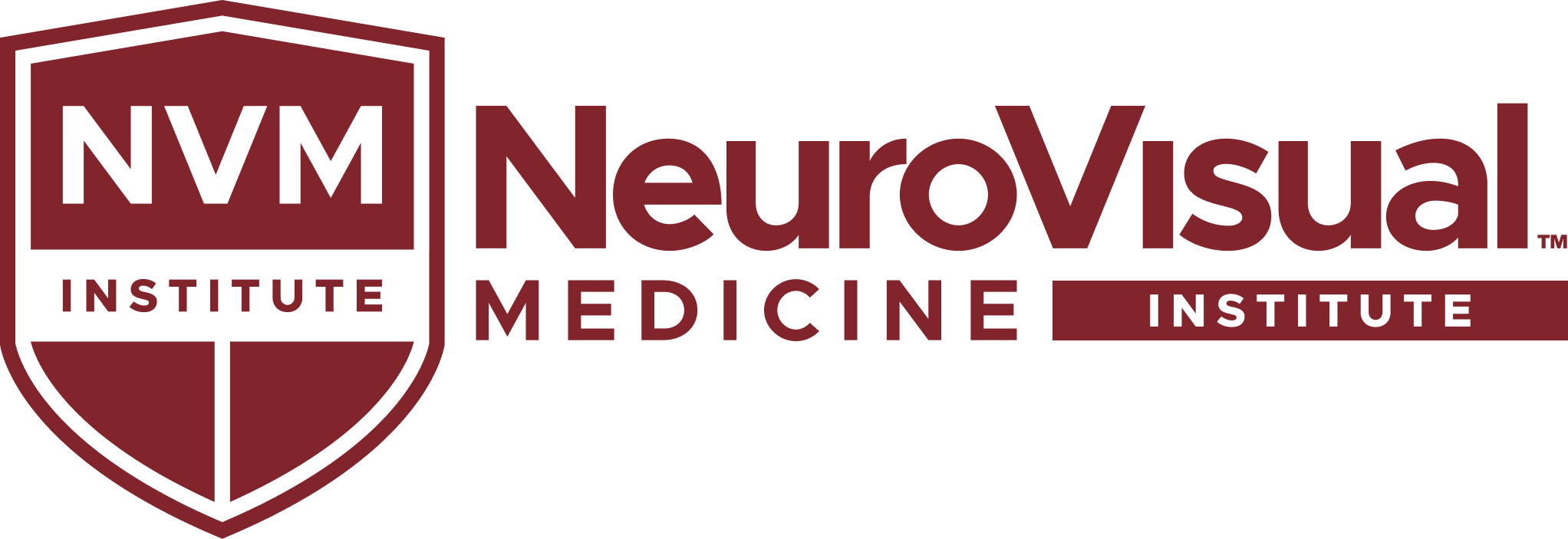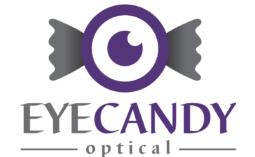
No Vision Plans, No Problem: Dr. Kandi's Path to Financial Freedom
After two decades in corporate eye care, Dr. Kandi Moller yearned for the freedom that comes with owning her own practice. Upon opening Eye Candy Optical in Gig Harbor, WA, she had her independence, but something wasn’t right. While she was no longer under the thumb of corporate oversight, she realized she was still being held back by another powerful force: vision insurance.
Practitioners who work with vision insurance often feel like there’s no way out - but Dr. Moller was able to achieve the freedom that she so badly desired by making a few simple changes: dropping vision insurance and picking up a unique, in-demand specialty.
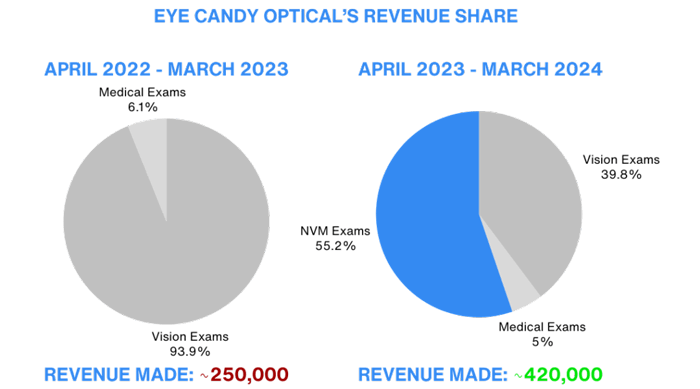
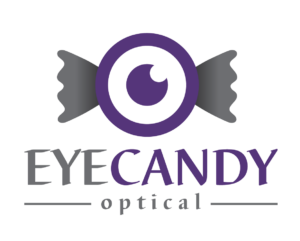
Fast Facts
- 1 Location
- 1 Doctor
- 1 Year with NVM
127
New BVD patients in 9 months
$1710
in revenue per patient exam
300%
increase in exam revenue with NVM
Want to Transform Your Practice?
Let's talk - book a consultation today!
Taking the Plunge: The Decision to Drop Vision Insurance
After opening Eye Candy Optical, Dr. Moller realized that there’s more to being independent than just being free the corporate practice model. Isn't true freedom about making choices for your practice on your terms rather than navigating the tightrope of vision insurance mandates? When faced with this question, Dr. Moller said she was fed up: “I don’t like being told what to do or how to do it. I don’t like my patients having limitations on their choices or the way vision plans funnel patients to their retail stores and brands.”
After some late-night soul-searching, Dr. Moller chose the road less traveled — in her words, “I decided to kick all vision plans to the curb. I dealt with a few when I was in corporate, and I didn’t want to have that cancer in my office.”
In the early days, she questioned her decision, especially when looking for new cash-pay specialties to transform her business. This led her to jump into a new practice area hastily: “I tried myopia management, thinking, this is the best thing, everybody’s doing it and you’re going to be committing malpractice if you don’t offer it.”
She quickly realized that she didn’t have enough pediatric patients to get this specialty off the ground and had to accept that myopia management isn’t a good fit for every practice. It was back to the drawing board, but this time Dr. Moller was determined to cast a wider net for her practice growth. This is what led her to NeuroVisual Medicine.
The (Reluctant) Discovery of NVM
Looking for a way to boost revenue while differentiating her practice from others in her area led Dr. Moller to the NeuroVisual Medicine Institute (NVMI). Initially, she was hesitant: “In school, I detested binocular vision. I didn’t understand it, but NVMI convinced me it was a needed specialty.”
But the more she learned about the profitability of this work and the fact that an estimated 1 in 5 patients suffer from binocular vision dysfunction (BVD), the more clearly the opportunitiy appeared. Especially since many doctors have limited confidence in identifying and treating this condition, most patients with BVD end up going from doctor to doctor with very few answers and limited symptom relief for their neck strain, nausea, dizziness, and more.
Upon hearing about this, the lightbulb went on for Dr. Moller, and it kept getting brighter the more she learned: “This isn’t something we’re taught in school. We’re not taught that microprism can make a difference, but I saw it happening realtime.”
Newly convinced, she enrolled in NVMI’s comprehensive coursework. “The training was phenomenal. You watch a little, you get to do a little, then there’s lots of discussion. I’m famous for my stupid questions but [NVMI] didn’t make me feel like I was stupid.”
Finding Sustainable Practice Success
Equipped with an understanding of BVD and microprism, Dr. Moller was nervous about repeating the mistakes she made with myopia management, but this time was different.
She was able to harness the local demand for these services and NVMI provided the support she needed to start growing her specialty practice, offering clinical coaching, business implementation strategies, and support with generating BVD leads: “I definitely had handholding after the training, which is what I wanted.” Contrasting with her experience with myopia management, she added, “some programs train you and then you’re left on your own, barely able to keep your head above water. NVMI was in the boat next to me, giving me a life jacket when I needed one until I was ready to be in the ocean all by myself.”
The impact was immediate for her practice. The BVD patients came more and more frequently as she built her reputation as a specialist. Working with these patients became a larger focus (and source of revenue) over time: “Within the first three months, I netted enough growth to pay off the training program. I made a minimum of $25,000 just from BVD for exams and glasses. For a newer office that doesn’t take vision plans, that’s phenomenal.”
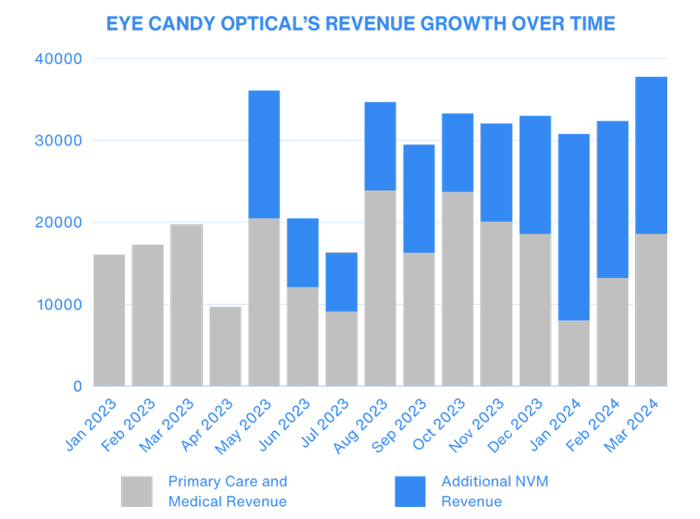
The Freedom to Build the Ideal Practice
The result is that Dr. Moller’s practice changed drastically. Just a few years ago, she was wondering if getting out from under the thumb of managed care was even possible. Now, she gets to enjoy the kind of freedom in her practice to explore more ways to specialize her business while providing value to her patients instead of large corporate insurance companies.
Free of the hamster wheel, she said she schedules one-hour exams, so patients have enough time with their eye doctor: “I don’t have to see 3-6 patients per hour anymore. My patients feel cared for. I also feel like I have the financial backing to be able to branch out into another specialty. NVM let me do that.”
All it took was for her to realize freedom isn't just about going solo — it's about calling the shots without someone else editing the script. Reflecting on her journey, Dr. Moller said she owes a lot of her satisfaction to NVMI. “We love BVD patients because they’re not tied to their vision discount plans. If not for NVMI I'd be screwed."
True Freedom Can Mean Making a Big Change
Many ECPs are too worried about making the wrong move. Dr. Moller’s story shows that making calculated risks can be the key to finding your ideal practice state.
Is it time to take control of your practice? Book a consultation to learn how dropping vision insurance can be the first step to transforming your business for the better.
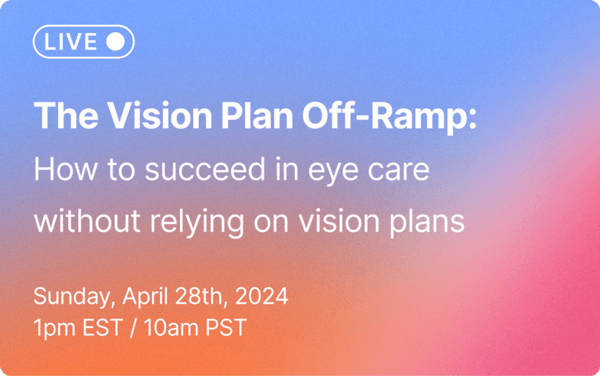
⦿ Live Webinar
The Vision Plan Off ramp: How to succeed in eye care without relying on vision plans
Hear from industry experts and a successful practice owner on the pitfalls of vision plans, and more importantly, how to break free for sustainable practice growth.



Read more customer stories


